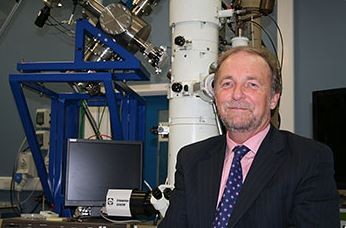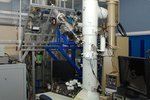Scientists at the University of Huddersfield in England will embark on a £1 million project to provide the nuclear power industry with scientific data to improve the safety of future generations of reactors and radioactive waste storage solutions.
The university says the project will also help increase the currently low number of nuclear scientists and engineers in the UK.
The University has an electron microscope named MIAMI, which stands for Microscope and Ion Accelerator for Materials Investigations facility.
The MIAMI facility is unique in the UK, and only one of two in Europe. It safely simulates the effects of radiation damage on materials with the use of ion beams. The electron microscope allows scientists to carry out examinations at the nanoscale (on a scale of 10−9 metre).

The electron microscope MIAMI (Microscope and Ion Accelerator for Materials Investigations facility). (Image: University of Huddersfield)
The electron microscope was co-developed by Professor Stephen Donnelly, Dean of the School of Computing and Engineering. Prof. Donnelly leads the Huddersfield team that has been awarded a £889,839 grant by the EPSRC (Engineering and Physical Sciences Research Council).
The 3.5-year project will investigate the damage caused by irradiation of the materials used for building reactors. The team will also investigate the long-term, safe disposal of radioactive waste.
Neutrons and other particles can weaken and alter the physical dimensions of materials, while a helium accumulation can make materials brittle and more likely to fracture.
Professor Donnelly and Senior Research Fellow Dr. Jonathan Hinks will lead a team that will investigate these issues.

Professor Donnelly sitting next to MIAMI. (Image: University of Huddersfield)
Dr. Hinks said “The project is about producing a base line of experimental evidence.” The scientists will use ion beams to irradiate thin samples of material, he explained.
Dr. Hinks added:
“You have to have a very thin piece of material – typically 100 nanometers or less – otherwise the electrons won’t get through and you can’t see anything.”
MIAMI uses electrons in the same way a conventional microscope uses light. It allows scientists to see inside super-thin samples of material and observe changes caused by irradiation, including the accumulation of gas bubbles.
Ion energy and temperatures can be varied during the experiments, and the result will be a database of data about the effects of irradiation at the nanoscale that can then be scaled up by researchers selecting materials for reactors and for waste disposal.
The UK will soon build Generation III+ reactors. The findings from this project will be relevant to those reactors, the researchers say. The materials for these reactors have already been selected, Dr. Hinks said, but regulatory authorities require constant safety updates and the MIAMI data will enable engineers to predict how reactors will fare over time.

Huddersfield University’s Chancellor Professor Sir Patrick Stewart (left) with Dr. Jonathan Hinks. (Image: Huddersfield University)
The project will also help planners decide which materials to use for the Generation IV reactors which are due to come on stream in the 2030s.
The project is divided into two strands: 1. Structural nuclear materials. 2. Nuclear waste storage.
The MIAMI research team will have two additional post-doctoral researchers. They will be appointed early this year, and will each be assigned to one of the two strands.
Another important dimension of this project, Dr. Hinks explained, is the training of new nuclear scientists. The UK currently has a serious shortage of nuclear scientists.
Dr. Hinks said:
“Because there was a lack of investment in nuclear research and development in the 80s and 90s, the demographic of the people who work in the industry has shifted towards retirement age. So there is a skill gap, particularly serious when you consider the expansion of the UK’s nuclear capacity that is now planned.”

